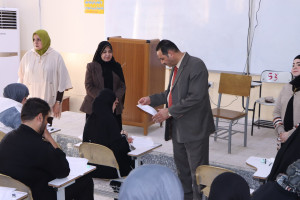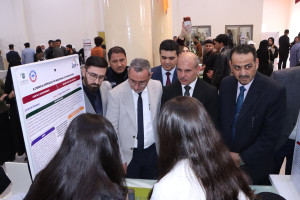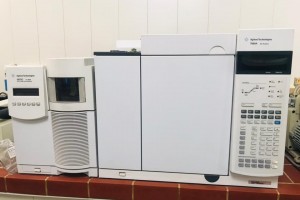
The College of Education for Pure Sciences at the University of Basrah in the Chemistry Department discussed a master’s thesis on the preparation, theoretical study and anti-cancer effectiveness of some carbonylthiourea derivatives and their metal complexes with copper(II).
The thesis presented by the researcher (Yaqin Muslim Mashjar) included three main axes:
The first axis:
Preparation of seven compounds of carbonylthiourea derivatives in two steps by reacting (benzoyl chloride or paranitrobenzoyl chloride) with ammonium thiocyanate and then reacting the resulting product with different amines. These compounds were identified using infrared spectroscopy (FT-IR), as well as using proton nuclear magnetic resonance (1H-NMR). The most important expected signals appeared for protons in the main groups of the compounds, as well as using carbon nuclear magnetic resonance (13C-NMR), and they were also diagnosed using mass spectrometry. (Mass) and knowing the molecular ion and the basic ion.
Complexes of these ligands with copper (II) were also prepared and were characterized by infrared spectroscopy, mass spectrometry, and thermogravimetric analysis (TGA). Molar conductivity and magnetic susceptibility were also studied. The study showed that the seven prepared ligands behaved as two-chamber ligands (S, O) with copper (II) and that the bonding ratio between them was (1:2).
The microstructure was also studied using scanning electron microscope (SEM) and energy dispersive X-ray spectroscopy (EDX) of the ligands L6 and L7 and their complexes. The results proved that the ligands and complexes differ in the shape of their external surfaces. The results of the EDX analysis also demonstrated the presence of the elements that make up the ligand and the complex only and the absence of impurities in them. Samples.
The second axis:
The second section included a computer study of the ligands prepared using the Gaussian 09 program and the density function theory (DFT) within the B3LYP level and using the 6-31G(d,p) rule. The total energy, HOMO and LUMO energies, the ΔELumo-Homo energy gap, the Mullican charge, and bond lengths and angles were calculated. Tri- and quaternary ligands prepared. Through the results of the structural parameters, it was known that the studied parts of the ligands have a planar structure. As for the energy calculations, the ligand L5 shows that the ligand L5 has the lowest value of the energy gap ΔELumo-Homo, and this indicates that it is the most effective ligand. Through the shapes of the HOMO orbitals and the Mullican charges, it was confirmed that the oxygen and sulfur atoms are the donor atoms in the ligands.
The third axis: includes some applications on ligands and complexes
The biological activity against breast cancer cells type MCF-7 was measured for five ligands and two complexes, namely CuL2 and CuL3. The cytotoxic effect was examined using the MTT method. The results showed that the ligands had low effectiveness against cancer cells, as their IC50 values ranged between (µg /mL 66.07-237.87). In contrast, the two complexes [Cu(L2)2] and [Cu(L3)2] showed high effectiveness, as their IC50 values were equal to (4.03 μg /mL, 4.66), respectively.
Molecular docking of the complexes [Cu(L2)2] and [Cu(L3)2] was also studied to determine their association with the active sites of the proteins responsible for breast cancer type 7-MCF and their ability to inhibit cancer cells using the (MOE 2019) Molecular program. Operating Environment, the values of the binding energy and the root mean square deviation (RMSD) were calculated, in addition to determining the number of connections occurring between the studied compounds and the receptor proteins. From the results, it was noted that the studied complexes had strong associations with the proteins PR (PDP: 4OAR) and Akt (PDP: 5KCV), as they gave the lowest binding energy (S) and the lowest RMSD values.
The message aims to:
Preparation of ligands for carbonylthiourea derivatives derived from benzoyl chloride and paranitrobenzoyl chloride and preparation of their coordination complexes with copper (II) ion.
Diagnosis of ligands prepared by diagnostic methods such as IR, 1H-NMR, 13C-NMR, and mass spectrometry, and diagnosis of complexes by spectroscopic, thermal, and magnetic susceptibility methods, in addition to conductivity measurements. And evaluate the biological effectiveness of the prepared compounds as antibodies to MCF-7 breast cancer cells.
A theoretical study using computational chemistry to determine the structural and electronic properties of the prepared compounds and link theoretical results to practical results. In addition to studying the molecular docking of compounds that have shown high biological activity to determine the locations of their binding with the proteins responsible for breast cancer

 .
.







